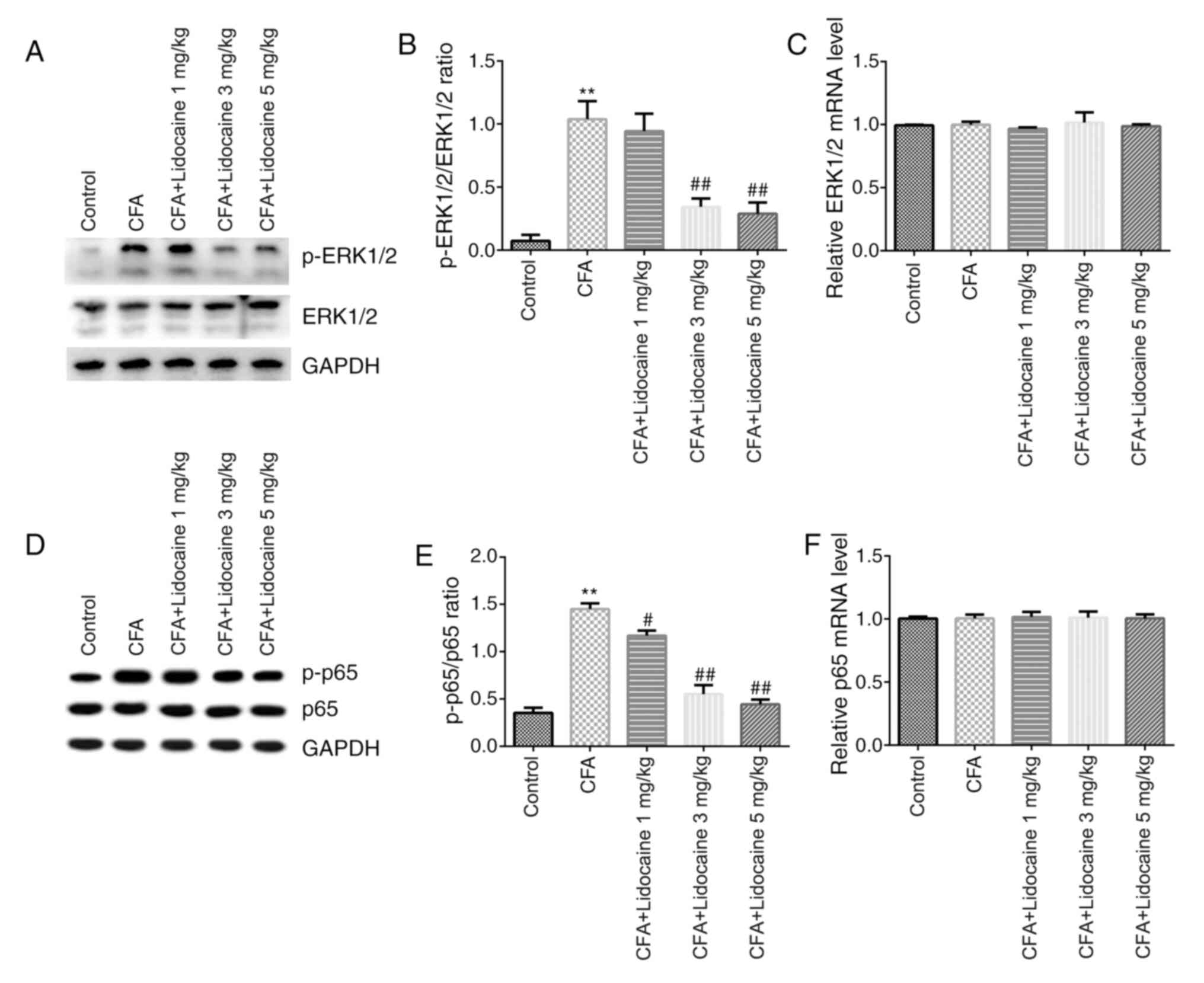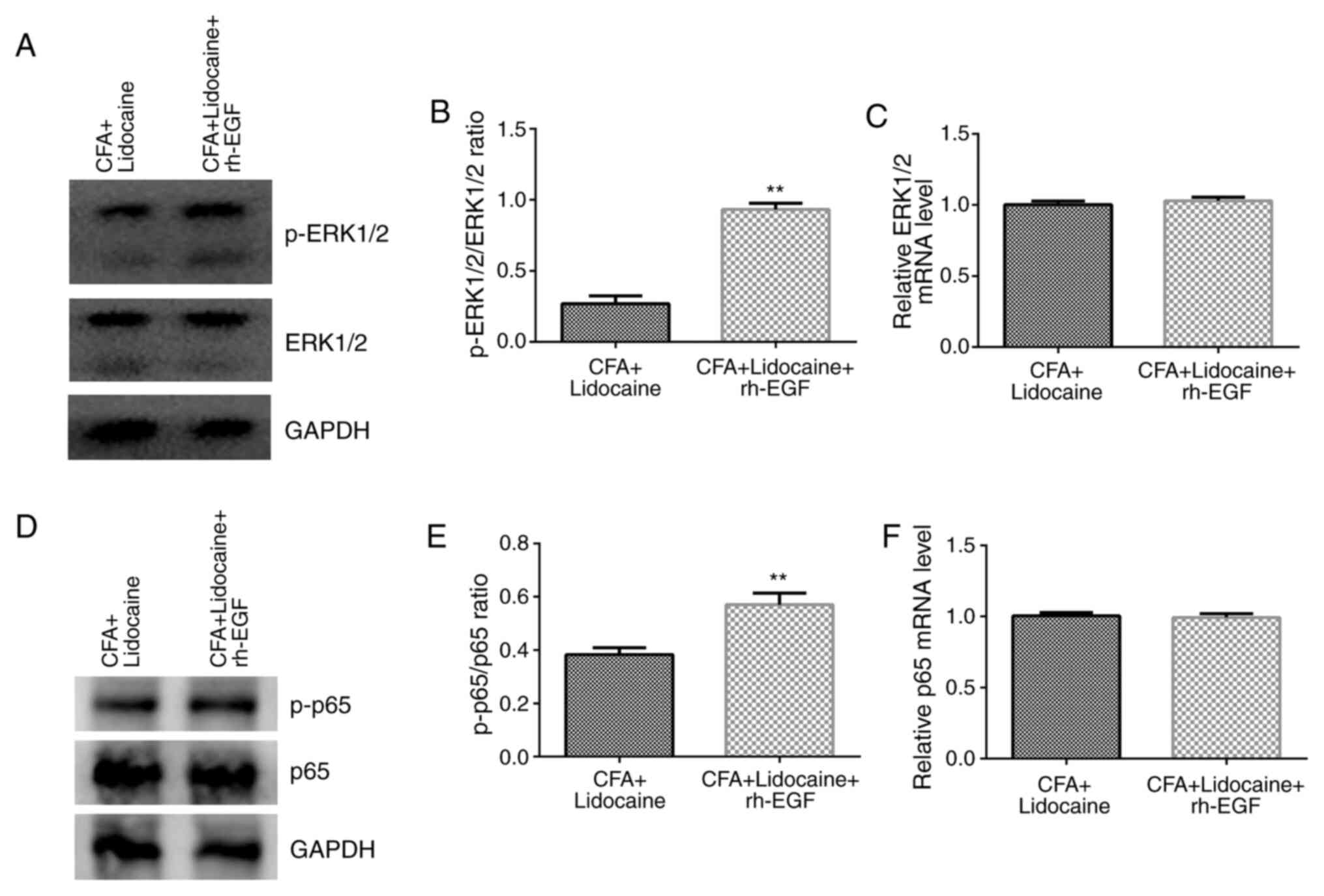|
1
|
Swieboda P, Filip R, Prystupa A and Drozd
M: Assessment of pain: Types, mechanism and treatment. Ann Agric
Environ Med. 1:2–7. 2013.PubMed/NCBI
|
|
2
|
Grace PM, Hutchinson MR, Maier SF and
Watkins LR: Pathological pain and the neuroimmune interface. Nat
Rev Immunol. 14:217–231. 2014.PubMed/NCBI View
Article : Google Scholar
|
|
3
|
Fang JQ, Du JY, Liang Y and Fang JF:
Intervention of electroacupuncture on spinal p38 mapk/atf-2/vr-1
pathway in treating inflammatory pain induced by CFA in rats. Mol
Pain. 9(13)2013.PubMed/NCBI View Article : Google Scholar
|
|
4
|
Del Giorno R, Frumento P, Varrassi G,
Paladini A and Coaccioli S: Assessment of chronic pain and access
to pain therapy: A cross-sectional population-based study. J Pain
Res. 10:2577–2584. 2017.PubMed/NCBI View Article : Google Scholar
|
|
5
|
Zhang B, He XL, Ding Y and Du GH:
Gaultherin, a natural salicylate derivative from gaultheria
yunnanensis: Towards a better non-steroidal anti-inflammatory drug.
Eur J Pharmacol. 530:166–171. 2006.PubMed/NCBI View Article : Google Scholar
|
|
6
|
Chamaraux-Tran TN and Tobias P: The amide
local anesthetic lidocaine in cancer surgery-potential
antimetastatic effects and preservation of immune cell function? A
narrative review. Front Med (Lausanne). 4(235)2017.PubMed/NCBI View Article : Google Scholar
|
|
7
|
Johnson MZ, Crowley PD, Foley AG, Xue C,
Connolly C, Gallagher HC and Buggy DJ: Effect of perioperative
lidocaine on metastasis after sevoflurane or ketamine-xylazine
anaesthesia for breast tumour resection in a murine model. Br J
Anaesth. 121:76–85. 2018.PubMed/NCBI View Article : Google Scholar
|
|
8
|
Lauretti GR: Mechanisms of analgesia of
intravenous lidocaine. Rev Bras Anestesiol. 58:280–286.
2008.PubMed/NCBI View Article : Google Scholar : (In En,
Portuguese).
|
|
9
|
Kawamata M, Takahashi T, Kozuka Y, Nawa Y,
Nishikawa K, Narimatsu E, Watanabe H and Namiki A: Experimental
incision-induced pain in human skin: Effects of systemic lidocaine
on flare formation and hyperalgesia. Pain. 100:77–89.
2002.PubMed/NCBI View Article : Google Scholar
|
|
10
|
Wang L, Wang M, Li S, Wu H, Shen Q, Zhang
S, Fang L and Liu R: Nebulized lidocaine ameliorates allergic
airway inflammation via downregulation of TLR2. Mol Immunol.
97:94–100. 2018.PubMed/NCBI View Article : Google Scholar
|
|
11
|
Chiu KM, Lu CW, Lee MY, Wang MJ, Lin TY
and Wang SJ: Neuroprotective and anti-inflammatory effects of
lidocaine in kainic acid-injected rats. Neuroreport. 27:501–507.
2016.PubMed/NCBI View Article : Google Scholar
|
|
12
|
van der Wal SEI, van den Heuvel SAS,
Radema SA, van Berkum BFM, Vaneker M, Steegers MAH, Scheffer GJ and
Vissers KCP: The in vitro mechanisms and in vivo efficacy of
intravenous lidocaine on the neuroinflammatory response in acute
and chronic pain. Eur J Pain. 20:655–674. 2016.PubMed/NCBI View
Article : Google Scholar
|
|
13
|
Liu LM, Liang DY, Ye CG, Tu WJ and Zhu T:
The UII/UT system mediates upregulation of proinflammatory cytokines
through p38MAPK and NF-κB pathways in LPS stimulated Kupffer cells.
PLoS One. 10(e0121383)2015.PubMed/NCBI View Article : Google Scholar
|
|
14
|
Wang HL, Xing YQ, Xu YX, Rong F, Lei WF
and Zhang WH: The protective effect of lidocaine on septic rats via
the inhibition of high mobility group box 1 expression and NF-κB
activation. Mediators Inflamm. 2013(570370)2013.PubMed/NCBI View Article : Google Scholar
|
|
15
|
Nagakura Y, Okada M, Kohara A, Kiso T,
Toya T, Iwai A, Wanibuchi F and Yamaguchi T: Allodynia and
hyperalgesia in adjuvant-induced arthritic rats: Time course of
progression and efficacy of analgesics. J Pharmacol Exp Ther.
306:490–497. 2003.PubMed/NCBI View Article : Google Scholar
|
|
16
|
Bai G, Ambalavanar R, Wei D and Dessem D:
Downregulation of selective microRNAs in trigeminal ganglion
neurons following inflammatory muscle pain. Mol Pain.
3(15)2007.PubMed/NCBI View Article : Google Scholar
|
|
17
|
Bayne K: Revised guide for the care and
use of laboratory animals available American physiological society.
Physiologist. 39:208–211. 1996.PubMed/NCBI
|
|
18
|
Tan SS, Liu H, Wang YZ and Zhu SS: The
molecular mechanisms associated with the effects of propofol in a
rat model of pain due to inflammation following injection with
complete freund's adjuvant. Med Sci Monit. 25:10190–10197.
2019.PubMed/NCBI View Article : Google Scholar
|
|
19
|
Livak KJ and Schmittgen TD: Analysis of
relative gene expression data using real-time quantitative PCR and
the 2(-Delta Delta C(T)) method. Methods. 25:402–408.
2001.PubMed/NCBI View Article : Google Scholar
|
|
20
|
Klein JA and Jeske DR: Estimated maximal
safe dosages of tumescent lidocaine. Anesth Analg. 122:1350–1359.
2016.PubMed/NCBI View Article : Google Scholar
|
|
21
|
Yang X, Yang LX, Wu J, Guo ML, Zhang Y and
Ma SG: Treatment of lidocaine on subacute thyroiditis via
restraining inflammatory factor expression and inhibiting
pyroptosis pathway. J Cell Biochem: Apr 8, 2019 (Epub ahead of
print).
|
|
22
|
Leon-Constantin MM, Alexa-Stratulat T,
Luca A, Tamba BI, Trandafir LM, Harabagiu V and Cojocaru E: The
morphofunctional impact of topical lidocaine formulation in
inflammatory pain-experimental study. Rom J Morphol Embryol.
60:869–874. 2019.PubMed/NCBI
|
|
23
|
Soto G, Naranjo González M and Calero F:
Intravenous lidocaine infusion. Rev Esp Anestesiol Reanim.
65:269–274. 2018.PubMed/NCBI View Article : Google Scholar : (In En,
Spanish).
|
|
24
|
Berk T and Silberstein SD: The use and
method of action of intravenous lidocaine and its metabolite in
headache disorders. Headache. 58:783–789. 2018.PubMed/NCBI View Article : Google Scholar
|
|
25
|
Reeves DJ and Foster AE: Continuous
intravenous lidocaine infusion for the management of pain
uncontrolled by opioid medications. J Pain Palliat Care
Pharmacother. 31:198–203. 2017.PubMed/NCBI View Article : Google Scholar
|
|
26
|
Hermanns H, Hollmann MW, Stevens MF, Lirk
P, Brandenburger T, Piegeler T and Werdehausen R: Molecular
mechanisms of action of systemic lidocaine in acute and chronic
pain: A narrative review. Br J Anaesth. 123:335–349.
2019.PubMed/NCBI View Article : Google Scholar
|
|
27
|
Chen LJ, Ding YB, Ma PL, Jiang SH, Li KZ,
Li AZ, Li MC, Shi CX, Du J and Zhou HD: The protective effect of
lidocaine on lipopolysaccharide-induced acute lung injury in rats
through NF-κB and p38 MAPK signaling pathway and excessive
inflammatory responses. Eur Rev Med Pharmacol Sci. 22:2099–2108.
2018.PubMed/NCBI View Article : Google Scholar
|
|
28
|
Caminero A, Comabella M and Montalban X:
Tumor necrosis factor alpha (TNF-α), anti-TNF-α and demyelination
revisited: An ongoing story. J Neuroimmunol. 234:1–6.
2011.PubMed/NCBI View Article : Google Scholar
|
|
29
|
Luo Y, Pang Z, Zhu Q, Cai X, Yin Y, Wang
M, Zhu J, Chen J, Zeng K, Zhang C and Zhang J: Locally instilled
tumor necrosis factor-α antisense oligonucleotide inhibits allergic
inflammation via the induction of Tregs. J Gene Med. 14:374–383.
2012.PubMed/NCBI View
Article : Google Scholar
|
|
30
|
Slaats J, Ten Oever J, van de Veerdonk FL
and Netea MG: IL-1β/IL-6/CRP and IL-18/ferritin: Distinct
inflammatory programs in infections. PLoS Pathog.
12(e1005973)2016.PubMed/NCBI View Article : Google Scholar
|
|
31
|
Dai T, Shi KQ, Chen G, Shen YM and Pan T:
Malvidin attenuates pain and inflammation in rats with
osteoarthritis by suppressing NF-κB signaling pathway. Inflamm Res.
66:1075–1084. 2017.PubMed/NCBI View Article : Google Scholar
|
|
32
|
Dokumaci A: Performing pain and
inflammation: Rendering the invisible visible. AMA J Ethics.
19:834–838. 2017.PubMed/NCBI View Article : Google Scholar
|
|
33
|
Barrientos RM, Hein AM, Frank MG, Watkins
LR and Maier SF: Intracisternal interleukin-1 receptor antagonist
prevents postoperative cognitive decline and neuroinflammatory
response in aged rats. J Neurosci. 32:14641–14648. 2012.PubMed/NCBI View Article : Google Scholar
|
|
34
|
Wan Y, Xu J, Ma D, Zeng Y, Cibelli M and
Maze M: Postoperative impairment of cognitive function in rats: A
possible role for cytokine-mediated inflammation in the
hippocampus. Anesthesiology. 106:436–443. 2007.PubMed/NCBI View Article : Google Scholar
|
|
35
|
Yuan Y, Zhang Y, He X and Fan S:
Protective effects of sinomenine on CFA-induced inflammatory pain
in rats. Med Sci Monit. 24:2018–2024. 2018.PubMed/NCBI View Article : Google Scholar
|
|
36
|
Brown MD and Sacks DB: Compartmentalised
MAPK pathways. Handb Exp Pharmacol. 186:205–235. 2008.PubMed/NCBI View Article : Google Scholar
|
|
37
|
Aouadi M, Binetruy B, Caron L, Le
Marchand-Brustel Y and Bost F: Role of MAPKs in development and
differentiation: Lessons from knockout mice. Biochimie.
88:1091–1098. 2006.PubMed/NCBI View Article : Google Scholar
|
|
38
|
Zhong W, Shen WF, Ning BF, Hu PF, Lin Y,
Yue HY, Yin C, Hou JL, Chen YX, Zhang JP, et al: Inhibition of
extracellular signal-regulated kinase 1 by adenovirus mediated
small interfering RNA attenuates hepatic fibrosis in rats.
Hepatology. 50:1524–1536. 2009.PubMed/NCBI View Article : Google Scholar
|
|
39
|
Giridharan S and Srinivasan M: Mechanisms
of NF-κB p65 and strategies for therapeutic manipulation. J Inflamm
Res. 11:407–419. 2018.PubMed/NCBI View Article : Google Scholar
|
|
40
|
Sunami Y, Leithäuser F, Gul S, Fiedler K,
Güldiken N, Espenlaub S, Holzmann KH, Hipp N, Sindrilaru A, Luedde
T, et al: Hepatic activation of IKK/NFκB signaling induces liver
fibrosis via macrophage-mediated chronic inflammation. Hepatology.
56:1117–1128. 2012.PubMed/NCBI View Article : Google Scholar
|
|
41
|
Chen X, Liu C, Lu Y, Yang Z, Lv Z, Xu Q,
Pan Q and Lu L: Paeoniflorin regulates macrophage activation in
dimethylnitrosamine-induced liver fibrosis in rats. BMC Complement
Altern Med. 12(254)2012.PubMed/NCBI View Article : Google Scholar
|
|
42
|
Gao Y, Xi B, Li J, Li Z, Xu J, Zhong M, Xu
Q, Lian Y, Wei R, Wang L, et al: Scoparone alleviates hepatic
fibrosis by inhibiting the TLR-4/NF-κB pathway. J Cell Physiol: Oct
8, 2020 (Epub ahead of print).
|
|
43
|
Liu CH, Hua N, Fu X, Pan YL, Li B and Li
XD: Metformin regulates atrial SK2 and SK3 expression through
inhibiting the PKC/ERK signaling pathway in type 2 diabetic rats.
BMC Cardiovasc Disord. 18(236)2018.PubMed/NCBI View Article : Google Scholar
|














